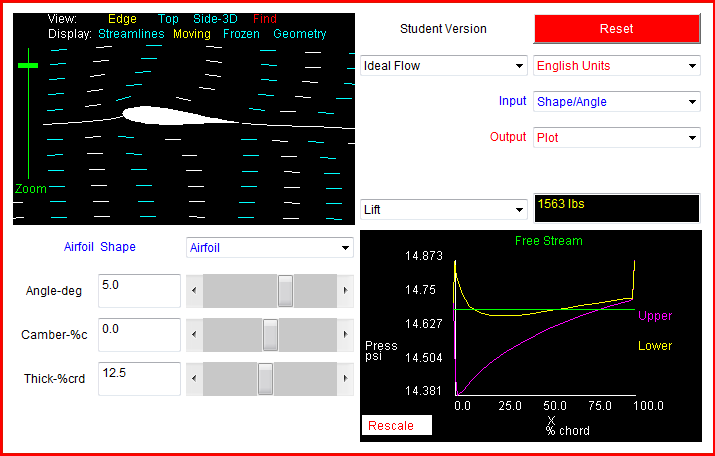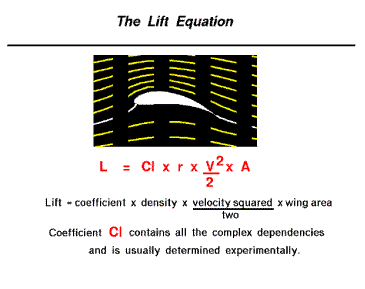The Lift Equation
Investigating the Lift Equation

The Lift Equation
Directions
Print the worksheet page before starting the project if the teacher hasn't already printed them for you. (Print it double sided if possible.)
Then:
- Answer the first two questions by looking at the Lift Equation box above the questions.
- Solve the Lift Equation for the stated variable in each line of the table following the first two questions. Show your work in the middle column and write the final result in the last column.
- Answer the next four questions using the appropriate formula from the table you just completed and the values in the problems.
- Go to the FoilSim applet
page.
Click the Reset button to set the following conditions:

To begin checking your calculations:
Change the Angle-deg value to 0.0 and hit the ENTER key.
Change the Camber-%c value to 5.33 and hit the ENTER key.
Change the Thick-%crd value to 15.0 and hit the ENTER key.
The screen should now look like this:
Change the Input option to
Change the Speed to 180.0 and hit the ENTER key.
Change the Altitude-ft to 48000.0 and hit the ENTER key.
Change the
Earth - Average Day to Specify Fluid Density.Change the Density to 0.0004 and hit the ENTER key.
The screen should now look like this:

Change the Input option to Size.
Change the Chord-ft value to 2.5 (for a chord = 25). Hit the ENTER
key.
Change the Span-ft value to 8.0 (for a span of 80).
Hit the ENTER key.
Change the Area-sq ft to 20.00 (for an area of 2000). Hit the ENTER key.
{Remember: Lift and Area are directly proportional.
Since the area is over 1000 sq ft, we
divide area by 100, the span by 10 and the chord by 10 and enter those numbers.
When you get the lift, multiply it by 100 to get the
real value!}
Change the
AR correction to on.
We are looking for a Lift of 17100, so we should see a lift of 171.
The screen should now look like this:

For each of your four answers, change the appropriate values and check your answers.
-
For the first question,
- Change the Lift to Cl.
- Record the Cl value. (You should see that this value does not match your calculated Cl value.)
- We will use this Cl value later.
-
For the second question,
- Change the Cl back to Lift.
- Change the altitude to the appropriate value.
- Change the density to the appropriate value.
- Notice that the Lift is now incorrect. Adjust the veolcity to the value you calculated.
- Does your velocity value result in the correct lift (17100)?
- For the third question,
- Calculate the new weight after the fuel has been used. That will be your new lift.
- Change the density to what you calculated.
- Is the lift now what you calculated as your new lift?
- If not, re-calculate the density using the value you
recorded from the first question check.
- Enter the density you got using the Cl from FoilSim.
- Is the lift now close to what it should be after the fuel was used?
-
For the fourth question,
- Change the altitude to the appropriate value.
- Change the density to the appropriate value.
- Change the speed to the appropriate value.
- Record the new lift value. Is it close to what you calculated?
-
Use the answers from 1 to 4 to answer the last quaestion on the
worksheet.
Worksheet

Student Names:
__________________________________________________________________________
| What do we need to know in order to find the value of L in the equation above? | |
| What would we have to do to the equation if we wanted to find the value of Cl instead? |
Complete the following table and use the results to solve the problems below.
| Variable to solve for: | Original equation & work: | Final Equation: |
L |
|
|
Cl |
|
|
r |
|
|
V |
|
|
A |
|
Using the lift formula solved for the variable in question, answer each of the following:
| Suppose you are flying a 17,100 pound aircraft at 48,000 ft where the air density is 0.0004 slugs/cu ft. Your current cruising speed is 180 mph and the wing area of the aircraft is 2000 sq ft. You need to make some altitude changes and will need to know the "Lift Coefficient" of the aircraft in order to do so. What is the Cl for your aircraft? | Cl = |
| Due to heavy air traffic in the area at 48,000 ft, you are instructed to descend to 30,000 ft where the air density is 0.00089 slugs/cu ft. The weight and dimensions of the aircraft haven't changed, so you'll need to adjust your speed for the new cruising altitude. What should the new V be when you level off at 30,000 ft? | V = |
| After some time, 500 pounds of fuel have been used and the aircraft now weighs less. Assuming you haven't adjusted your speed since you began to cruise at 30,000 ft, what is the current air density, r, for your current altitude? | r = |
| After landing and unloading your cargo, your aircraft is re-fueled and you take off again for the return trip. The tower directs you to ascend to 25,000 ft where the air density is 0.00107 slugs/cu ft. You do so and level off. You are now flying at 80 mph and have the aircraft on autopilot. Out of curiosity, you decide to calculate how much your cargo weighed. Naturally, you'll need to know how much your aircraft weighs now so that it can be compared to the weight with all the cargo. So, how much does the aircraft weigh (L) now? How much did the cargo weigh? | L = |
Use FoilSim to test each of your four answers. Make sure to follow the
directions on the directions page.
| Now that you have tested the calculations you did above by entering the appropriate variable values for each
problem, does FoilSim agree with your calculations? If not, where do they differ? What
sources of error can you find? |